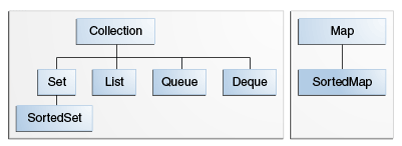More about Collections
Types Both classes and interfaces represent types. Here are the rules for being a sub/supertype
- If T is a subtype of S, then S is a supertype of T.
- Every type is a sub and supertype of itself.
- If T is a class type and S is an interface type and T implements S, then T is a subtype of S.
Rules for Pointing A variable of a given type can point at any object that is a subtype of the variable's type. For example, you can do these things.
- List<String> ell = new ArrayList<>();
- List<String> ell = new LinkedList<>();
- List<String> ell = new Vector<>();
Super and Sub Interfaces
Suppose S is a set. A relation R on S is a set of orderd pairs of elements of S Write xRy if (x,y) ∈ R. < on numbers x < x always false x < y then y < x (antisymmetric) if x < y and if y < z, then x < z (this is transitive) reflexive xRx for x ∈ S. symmetric: xRy guarantees yRx antisymmetric: xRy guarantees that yRx is FALSE. reflexive xRy guarantees yRx equivalence: a relation that is symmetric, reflexive and transtive 7 mRn if 7|m - n reflexive because 7|n - n = 0 If mRn 7| m - n 7 = (m - n)*q = (n - m)*(-q) so 7| n = m Symmetric! suppose mRn and nRp 7 | m - n and 7|n = p m - n = 7*q n - p = 7*r add m - p = 7*(q + r) 7| m - p mRp TRANSITIVE <= reflexive: x <= x transitive x <= y and y <= z then x < z. if x < y and y < x, x = y
The Java Collections Framework
These interfaces form the "skeleton" of the Collections Framwork. This diagram depicts the subtype relations among the various interfaces.
